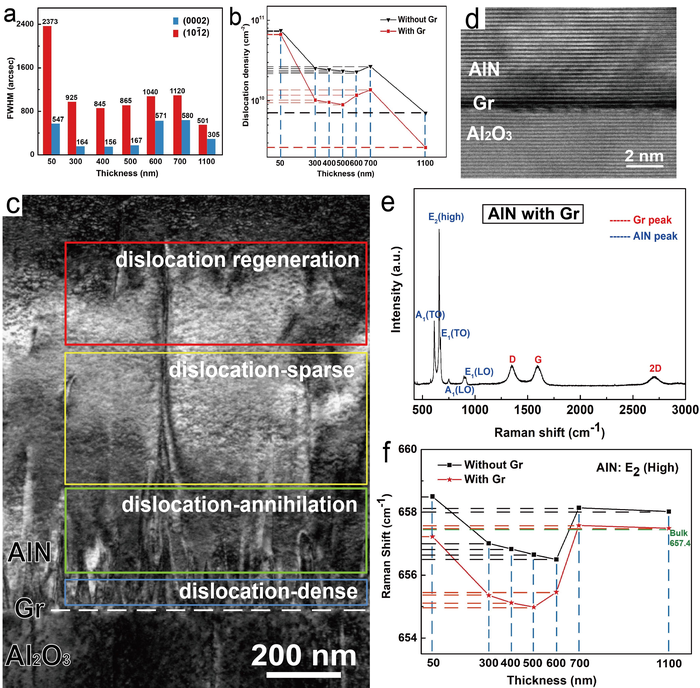Reviewed by Alex SmithApr 11 2022
AlN-based materials’ straight band gap makes them ideal for producing DUV optoelectronic devices, which have a variety of applications in curing, water and air disinfection, medicine and biochemistry, among other things.
 a FWHMs XRCs of AlN epilayer with various thicknesses grown on Gr-buffered sapphire. b Estimated DD of the AlN films with and without Gr buffer layer with various thicknesses. c DF images of epitaxial AlN/Gr/sapphire with g = [0002]. d HRTEM image of the AlN/Gr/sapphire interface. e Raman spectra of as-grown AlN/Gr/sapphire structure. f Relative Raman shifts of E₂ (high) of AlN with various growth thicknesses. Image Credit: Hongliang Chang, Zhetong Liu, Shenyuan Yang, Yaqi Gao, Jingyuan Shan, Bingyao Liu, Jingyu Sun, Zhaolong Chen, Jianchang Yan, Zhiqiang Liu, Junxi Wang, Peng Gao, Jinmin Li, Zhongfan Liu, Tongbo Wei
a FWHMs XRCs of AlN epilayer with various thicknesses grown on Gr-buffered sapphire. b Estimated DD of the AlN films with and without Gr buffer layer with various thicknesses. c DF images of epitaxial AlN/Gr/sapphire with g = [0002]. d HRTEM image of the AlN/Gr/sapphire interface. e Raman spectra of as-grown AlN/Gr/sapphire structure. f Relative Raman shifts of E₂ (high) of AlN with various growth thicknesses. Image Credit: Hongliang Chang, Zhetong Liu, Shenyuan Yang, Yaqi Gao, Jingyuan Shan, Bingyao Liu, Jingyu Sun, Zhaolong Chen, Jianchang Yan, Zhiqiang Liu, Junxi Wang, Peng Gao, Jinmin Li, Zhongfan Liu, Tongbo Wei
As a result, achieving high-quality epitaxy of AlN films is critical for ensuring outstanding DUV photoelectric device efficiency. Due to a shortage of cost-effective homogeneous substrates, heteroepitaxial development on sapphire is simply the leading option for growing AlN films.
Unfortunately, the intrinsic mismatches between AlN and the sapphire substrate invariably introduce crystallographic flaws within the AlN epilayer. The high residual strain in the AlN film, in fact, causes nonuniformity in the Al distribution in the higher AlGaN layer, as well as wafer bending, significantly limiting device performance.
As a result, a viable method is required to make a qualitative jump toward high-quality heteroepitaxial AlN film growth and to satisfy the application requirements of DUV optoelectronic devices.
For high-quality heteroepitaxial growth of group-III nitrides, a new approach known as quasi-van der Waals (QvdW) epitaxy or distant epitaxy based on two-dimensional (2D) material has emerged in recent years.
Graphene has been used as a buffer layer for epitaxial development of nitrides to efficiently reduce the lattice mismatch and thermal mismatch between the epilayer and the substrate since it is a well-studied 2D material.
Earlier reports of epitaxial nitride films on graphene typically quoted that the stress relaxation of the epitaxial system was achieved through the weak interaction among graphene and epilayers, even though there was no detailed explanation or strenuous verification of this claim.
Dou et al. recently used aberration-corrected transmission electron microscopy to perceive chemical bond formation at the interface between effectively grown graphene and sapphire and discovered a strong interaction between graphene and sapphire, which will undoubtedly subvert the traditional perception of stress relaxation through the use of weak vdW engagement among graphene and substrate.
As a result, the QvdW epitaxy mechanism of AlN films on graphene warrants further investigation, as it is critical for accurately manipulating the quality of AlN films and enhancing the performance of DUV optoelectronic devices.
Professor Tongbo Wei of the Research and Development Center for Semiconductor Lighting Technology, Institute of Semiconductors, Chinese Academy of Sciences, Beijing, 100083, China, and co-workers have effectively obtained a maximum strain-free AlN film through Gr-driving strain-pre-store engineering and displayed the novel method of strain-relaxation in QvdW epitaxy in a recent paper published in Light Science & Application.
Meanwhile, the strain-free AlN film formed on graphene/sapphire can be used as a dependable template layer for DUV-LED device epitaxy.
These sums up the highlights of their study:
“The dislocation density of AlN epilayer with graphene exhibits an anomalous sawtooth-like evolution during the QvdW epitaxy process and the values are consistently lower than that of on bare sapphire. Finally, graphene enables the AlN film to realize a 62.6% decrease of dislocation density.”
“First-principles calculation is introduced to elucidate the mechanism of graphene regulating the strain state of the AlN film. It is revealed that the plasma-treated graphene controls the initial nucleation morphology of AlN to pre-store sufficient tensile strain in the epilayer to compensate for the compressive strain caused by lattice and thermal mismatch during heteroepitaxy, thus bringing out a strain-free AlN film.”
“The reciprocal space mapping of the as-fabricated DUV-LED reveals a weak compressive strain in the 1.8 μm n-AlGaN layer, indicating that the strain-free AlN film as a reliable template layer enables the high-quality crystalline state of the upper LED epitaxial structure.”
“The as-fabricated 283 nm DUV LED with graphene exhibits 2.1 times higher light output power compared to its counterpart on bare sapphire and favorable stability of luminous wavelength under a current range from 10 mA to 80 mA, which is attributed to the better crystal quality with a weak residual strain of the epitaxial structure based on graphene.”
“This work reveals the internal mechanism of QvdW growth of nitride to improve the epitaxial quality on large-mismatched substrates and undoubtedly sheds light on the further promotion of nitride-based device manufacturing.”
Journal Reference:
Chang, H., et al. (2022) Graphene-driving strain engineering to enable strain-free epitaxy of AlN film for deep ultraviolet light-emitting diode. Light Science & Applications. doi.org/10.1038/s41377-022-00756-1.